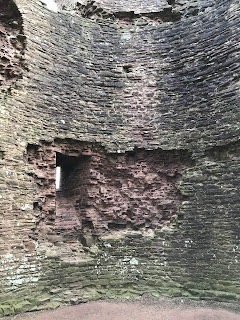Skenfrith, or if you wish Ynysgwynwraidd* lies on the banks of the Monnow ten miles northwest of Monmouth. It houses a fine pub called The Bell, a C17th coaching inn on the old road from Ross to Abergavenny, and one of the three castles built to hold down this area shortly after the Norman conquest.
As well as the castle, Skenfrith also boasts St Bridget’s Church, mentioned in 1207 and enlarged in the C14th. The village has been used in the Dr Who episodes ‘Amy’s Choice’ and in other episodes name-checked as the village ‘which time forgot.’
We went there last Wednesday.
My man, Hubert de Burgh, rebuilt the original castle as a state of the art early C13th fortress. An experienced soldier, he’d held many castles for the king in both England and France and had seen the advances made in military architecture. Hubert’s layout of a round central keep surrounded by a curtain wall foreshadowed the ‘concentric’ design of later castles like Beaumaris and Caerphilly.
In its prime
Today
The castle was built on low ground near the river and its crossing points into England. Strategically it made good sense but with one disadvantage. Built on low ground and surrounded by hills, it gave an advantage to those who attacked the castle. See photos above.
Hubert’s keep was the solution, dominating the castle and built high enough for its defenders to scan the surrounding countryside. Hubert’s private accommodation took up the two middle floors, height protecting it from winter floods and a great fireplace to warm his bedchamber.
as you can see.
Note how far away the river is today
Skenfrith stood guard over key crossing points on the River Monnow. Other strategic advantages included unlimited fresh water. In a previous warm period (global warming anyone?) the river was deeper and ran right up to the castle’s walls, which allowed the channelling of a moat on the other three sides. Being deeper, the river was also navigable for barges bringing supplies, as the ruins of a nearby wharf indicate.
Another tree with an identity crisis
In sight of the castle stands St Bridget’s Church, one of the oldest churches in Monmouthshire still in continuous use. The church was consecrated in 1207, extended in the late C14th and once more in the C17th. Note the squat and sturdy tower with its wooden belfry and the single huge buttress. No big bad wolf is going to blow this house down.
The stone altar is original, hidden under the church floor during the Reformation to save it being destroyed by Protestant zealots.
I tried to avoid the reflections, but couldn't. What's so wonderful about the two lists is the sense of history they impart and the questions they beg. What happened to David Lewis and his unnamed successor during the English Civll War? And how did Lewis Parry make his peace with the new king following the Restoration of 1660?
And then we have the Lords of Skenfrith, some famous, some less so. The last governor of the Three Castles, John Morgan, is buried in the church. His fine tomb stands weathered by time but evocative still.
The chest tomb has the effigies of John (d. 1557) and his wife Anna (d. 1564) and on its sides, beautifully carved figures of four kneeling men, likely their sons, four unknown women on the opposite side with wonderfully detailed costumes, and the couples' respective family coat of arms at either end.
And facing the church, clearly a witch's cottage, broomstick at the ready.
* Ynysgwynwraidd is Welsh for ‘Island of Cynfraeth’ - best guess a local C6th ruler – re-anglicised to the more easily pronounced Skenfrith.



























No comments:
Post a Comment